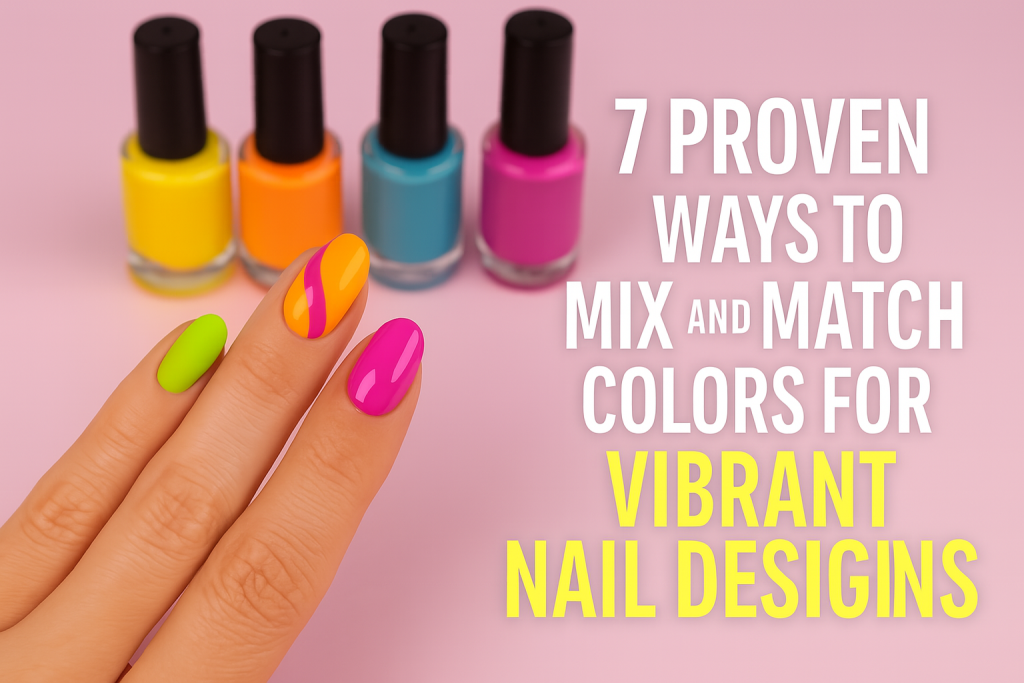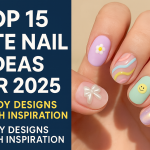Why Color Combinations Matter in Nail Art
Nail art has transformed into a creative expression that is as unique as your personal style. The way you mix and match colors can take your nail designs from basic to bold, making your hands a true canvas of vibrancy and fun. But with an endless selection of nail polish shades available, figuring out which colors complement each other can feel overwhelming.
Learning how to blend hues effectively is key to creating eye-catching, vibrant nail designs. The right combinations not only highlight your personality but also enhance the overall look of your manicure. Mastering color mixing brings harmony, depth, and a professional finish to your nail art, whether you prefer minimalist patterns or intricate creations.
Understanding Color Theory: The Foundation of Stunning Nails
To create successful nail color combinations, understanding the basics of color theory is crucial. Color theory helps you know which shades complement, contrast, or harmonize well together, making your nail art more intentional and visually appealing.
The Color Wheel and Nail Art
The color wheel is a fundamental tool for artists and nail techs alike. It divides colors into primary (red, yellow, blue), secondary (green, orange, purple), and tertiary shades. By referencing the wheel, you can easily spot combinations that will make your nails stand out.
- Complementary Colors: These are opposite each other on the wheel (e.g., blue and orange). Together, they create high-contrast, vibrant looks.
- Analogous Colors: These sit side by side (e.g., pink, red, orange) and create harmonious, subtle gradients.
- Triadic Colors: These are evenly spaced around the wheel (e.g., purple, green, orange), offering balance and variety.
Warm vs. Cool Tones
Understanding the difference between warm (reds, oranges, yellows) and cool (blues, greens, purples) tones will help you decide what mood or effect you want in your nail design. Warm tones feel energetic, while cool tones evoke calm and sophistication. Mixing both can bring a dynamic balance to your nails.
7 Proven Ways to Mix and Match Nail Colors for Vibrancy
- Choose a Vibrant Base and Accent ColorStart by selecting a bold base color that represents your personality or matches your outfit. Then, choose one or two accent shades. For example, a cobalt blue base with neon yellow or hot pink details makes the colors pop without overwhelming the eye.
This technique is especially effective for beginners. Use the accent color for stripes, dots, or geometric patterns to create a playful yet coordinated look.
- Go Monochromatic with Different ShadesIf you’re new to nail color mixing, go for a monochromatic scheme. Pick one color and use lighter and darker versions for an elegant ombré or gradient effect. For example, various shades of purple from lavender to deep violet look cohesive yet vibrant together.
This strategy works well for both minimalist and dramatic styles. Ombré nails remain one of the most popular requests at salons worldwide.
- Use Complementary Colors for ContrastPairing complementary colors like orange and blue or green and red creates a high-impact design perfect for making a statement. While bold, these combos are pleasing to the eye when used thoughtfully.
Try using one color as the main shade and the other as a subtle detail, or alternate them on each finger for added excitement.
- Create Harmonious Looks with Analogous ColorsAnalogous colors—such as pink, coral, and orange—blend effortlessly and are perfect for smooth transitions. This method is ideal for gradient nails or floral patterns, giving your manicure a natural flow and balanced vibrancy.
Using analogous shades also makes it easier to incorporate trendy seasonal colors while keeping your nail art cohesive.
- Incorporate Neutrals for BalanceFor ultra-vibrant colors, grounding them with neutral shades like white, black, or nude helps prevent your design from appearing too chaotic. Neutrals can be used as a canvas or to outline bold shapes, making bright colors stand out even more.
Try a white base with rainbow tips, or add nude negative space between vibrant blocks for a modern, high-impact effect.
- Mix in Metallics or GlitterFor an extra pop, pair your selected colors with metallics (gold, silver, rose gold) or glitter polishes. These finishes reflect light, add texture, and instantly elevate any color combination, making your design more fun and festive.
Consider metallic stripes over vibrant bases, or glitter-dipped tips that blend two bold colors for a party-ready manicure.
- Experiment with Patterns and TexturesSometimes, the way you arrange your colors makes all the difference. Patterns like color blocking, tie-dye, checkers, or even animal prints let you showcase multiple shades in creative ways. Mix glossy and matte topcoats for added dimension.
Don’t be afraid to try unusual pairings—you may discover your next signature style by breaking the rules and experimenting with abstract forms.
Expert Tips for Flawless Color Mixing on Nails
Test Combinations Before Applying
To ensure your colors work well together, paint small swatches on a nail wheel or a piece of paper. This quick step saves you from a complete redo if the colors clash or look different once dry.
Balance Bold and Subtle Shades
While mixing vibrant colors, balance them with softer or understated hues. This prevents your design from becoming visually overwhelming and maintains harmony across your nails.
Keep Seasonal Trends in Mind
Stay inspired by seasonal palettes. For example, use pastels in spring, brights in summer, jewel tones in fall, and cozy neutrals in winter. Incorporating trending colors can make your nail art feel current and exciting.
Don’t Forget About Your Skin Tone
Certain colors may pop more depending on your skin undertone. Try warm shades like coral and gold on warmer skin, or cool tones like blue and silver on cooler skin, to enhance your nails’ vibrancy.
Creative Nail Design Ideas Using Vibrant Color Combos
- Rainbow French Tips: Use a different bright color on each tip for a playful twist on the classic French manicure.
- Pastel Ombré: Blend several soft shades for a dreamy, gradient look that works year-round.
- Contrasting Dots or Stripes: Apply a bold dot or stripe pattern over a pastel or neutral base for high-impact nail art.
- Sunset Fade: Mix orange, pink, and purple for a sunset-inspired gradient that’s perfect for summer.
- Abstract Color Blocking: Use tape or nail stencils to create geometric shapes with two or more vibrant colors.
Common Mistakes to Avoid When Mixing Nail Colors
- Using Too Many Colors: Stick to 2-4 shades for the best balance and cohesion.
- Ignoring Drying Times: Allow each layer to dry before adding new colors or patterns to avoid smudging or color bleeding.
- Skipping Topcoat: Always finish with a topcoat to seal in your design, boost shine, and prevent chips.
- Overlooking Color Undertones: Pair cool with cool and warm with warm when in doubt for a harmonious look.
Conclusion: Elevate Your Nail Art with Confident Color Choices
With these 7 proven ways to mix and match nail colors, you have the tools and inspiration to create vibrant, unforgettable nail designs every time. Whether you’re a DIY enthusiast or a seasoned nail artist, mastering color combinations will transform your manicures and let your creativity shine.
Remember, the best nail art comes from experimentation and personal expression. Don’t be afraid to try new pairings, draw inspiration from nature, fashion, or art, and most importantly—have fun with your nail color adventures!


